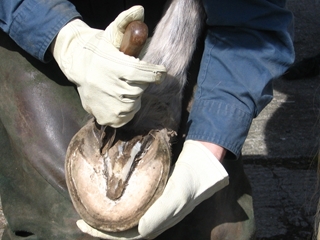
Equine Podiatry is the study of the Equine foot and everything that affects it.
An Equine Podiatrist (EP for short) is a specialist in equine feet – someone who has studied Equine Podiatry in depth and can use that knowledge to help you improve your horse’s feet. The role is similar to a farrier but an EP is not trained (or legally allowed) to work with shoes. As an EP, I can only do trimming work on horses (or donkeys, mules and hinnies for that matter) that are either being worked without shoes or are temporarily out of shoes while problems with the feet are sorted out. I can however provide advice on the management of shod horses to complement the work of your farrier.
My aim as an EP is to get the best possible feet under your horse. In part, I achieve that by trimming the feet to remove excess growth, correct temporary defects in the shape and to encourage stronger new growth – it’s a bit like pruning a rose bush (but far less drastic). But an equally important part of the job is to look at all the other factors that may be affecting your horse’s feet. These factors include things like stabling/turnout arrangements, exercise regimes and diet (perhaps one of the most important in my view). Many of the foot related problems that are common in horses (such as navicular disease, laminitis, cracks, etc.) are caused not so much by weaknesses in the hooves as by how the horse is managed and health issues relating to the whole horse. Even things such as saddle fit and rider position can have an impact on how the hooves grow. As such, to get the best out of your horse’s feet it’s essential to take a holistic view. As an EP, I can provide advice on all aspects of horse care that relate to feet as well as providing a hoof trimming service.
More and more horses are being worked without shoes these days. Contrary to popular opinion, barefoot horses can do pretty much anything shod horses can do. You can see examples of what barefoot horses trimmed by me and my colleagues get up to here. Working a horse without shoes can in many cases be simply a matter of pulling the shoes and getting on with it. Traditionally many ponies have been worked barefoot but few horses. It’s important to make sure that the feet are up to the job and as an EP I can not only help advise whether your horse is suitable to work barefoot now, I can also help improve the quality of the feet if they’re not yet good enough. Many people assume that breeds such as thorougbreds are not suitable to go barefoot, but with the correct management and trimming, most horses can do well without shoes.
There are numerous benefits to the Equine Podiatry approach. New techniques in hoof management are resulting in far better outcomes for conditions such as navicular disease, laminitis, quarter and toe cracks, frequent abscessing, etc. But even horses that appear to have no major foot problems can benefit from better quality hooves – often showing better gaits (e.g. more expressive trot, smoother canter, etc.) and generally improved performance.
You can find an article describing what an EP does and what to expect from a typical visit here.
If you are interested in training to become an EP, you can find details of the Diploma course in Equine Podiatry here.